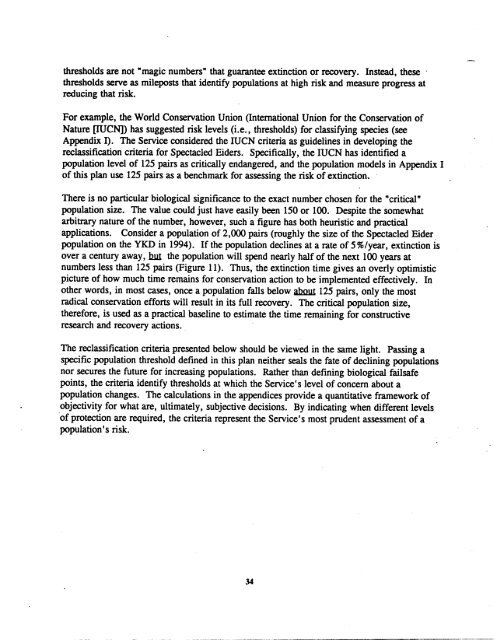A. Status of the Spectacled Eider - U.S. Fish and Wildlife Service
A. Status of the Spectacled Eider - U.S. Fish and Wildlife Service
A. Status of the Spectacled Eider - U.S. Fish and Wildlife Service
You also want an ePaper? Increase the reach of your titles
YUMPU automatically turns print PDFs into web optimized ePapers that Google loves.
thresholds are not “magic numbers” that guarantee extinction or recovery. Instead, <strong>the</strong>se<br />
thresholds serve as mileposts that identify populations at high risk <strong>and</strong> measure progress at<br />
reducing that risk.<br />
For example, <strong>the</strong> World Conservation Union (International Union for <strong>the</strong> Conservation <strong>of</strong><br />
Nature [IUGNI)has suggested risk levels (i.e., thresholds) for classifying species (see<br />
Appendix I). The <strong>Service</strong> considered <strong>the</strong> IUCN criteria as guidelines in developing <strong>the</strong><br />
reclassification criteria for <strong>Spectacled</strong> <strong>Eider</strong>s. Specificafly, <strong>the</strong> IUCN has identified a<br />
population level <strong>of</strong> 125 pairs as critically endangered, <strong>and</strong> <strong>the</strong> population models in Appendix I<br />
<strong>of</strong> this plan use 125 pairs as a benchmark for assessing <strong>the</strong> risk <strong>of</strong> extinction.<br />
There is no particular biological significance to <strong>the</strong> exact number chosen for <strong>the</strong> “critical”<br />
population size. The value could just have easily been 150 or 100. Despite <strong>the</strong> somewhat<br />
arbitrary nature <strong>of</strong> <strong>the</strong> number, however, such a figure has both heuristic <strong>and</strong> practical<br />
applications. Consider a population <strong>of</strong> 2,000 pairs (roughly <strong>the</strong> size <strong>of</strong><strong>the</strong> <strong>Spectacled</strong> <strong>Eider</strong><br />
population on <strong>the</strong> YKD in 1994). If <strong>the</strong> population declines at a rate <strong>of</strong> 5%/year, extinction is<br />
over a century away, but <strong>the</strong> population will spend nearly half <strong>of</strong> <strong>the</strong> next 100 years at<br />
numbers less than 125 pairs (Figure 11). Thus, <strong>the</strong> extinction time gives an overly optimistic<br />
picture <strong>of</strong> how much time remains for conservation action to be implemented effectively. In<br />
o<strong>the</strong>r words, in most cases, once a population falls below abQut 125 pairs, only <strong>the</strong> most<br />
radical conservation efforts will result in its full recovery. The critical population size,<br />
<strong>the</strong>refore, is used as a practical baseline to estimate <strong>the</strong> time remaining for constructive<br />
research <strong>and</strong> recovery actions.<br />
The reclassification criteria presented below should be viewed in <strong>the</strong> same light. Passing a<br />
specific population threshold defined in this plan nei<strong>the</strong>r seals <strong>the</strong> fate <strong>of</strong>declining populations<br />
nor secures <strong>the</strong> future for increasing populations. Ra<strong>the</strong>r than defining biological failsafe<br />
points, <strong>the</strong> criteria identify thresholds at which <strong>the</strong> <strong>Service</strong>’s level <strong>of</strong>concern about a<br />
population changes. The calculations in <strong>the</strong> appendices provide a quantitative framework <strong>of</strong><br />
objectivity for what are, ultimately, subjective decisions. By indicating when different levels<br />
<strong>of</strong> protection are required, <strong>the</strong> criteria represent <strong>the</strong> <strong>Service</strong>’s most prudent assessment <strong>of</strong> a<br />
population’s risk.<br />
34

















